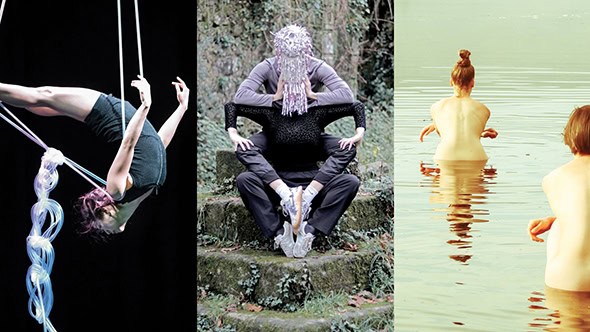Resolution 2019: works by Lam, Rouzet and Martinez, and Vivas
Posted: February 21st, 2019 | Author: Nicholas Minns & Caterina Albano | Filed under: Festival, Performance | Tags: Alejandro Martinez, Filipe Sousa, Heather Lam, Laura Rouzet, Lynn Dichon, Mara Vivas, Matthias Strahm, Resolution 2019, Tara Silverthorn | Comments Off on Resolution 2019: works by Lam, Rouzet and Martinez, and VivasResolution 2019: works by Heather Lam, Rouzet and Martinez, and Mara Vivas, February 12

One can almost sense the curatorial hand putting these three works together on an apparent theme of insubstantiality. Hazel Lam ‘aims to highlight the power in gentleness’; Laura Rouzet and Alejandro Martinez set out to explore ‘genderless movement’ and Mara Vivas translates time into space. This is not so much a program of action but one of reflection where dance evolves from the physical to the metaphysical. In reality it is only Vivas who follows through by refusing to compromise.
It’s the set of Heather Lam’s Lighthouse that initiates us to the nature of the evening, a suspended forest of translucent soft pvc tubes arranged like the tentacles of underwater sculptures. Just upstage the seated figure of Lam sways in the tide to the chatter of the arriving audience until the lighting of Bert Van Dijck and Margot Jensens submerges us in this marine environment. Lam indulges in some innocent foreplay discovering the translucent tubes in which — a little disingenuously — she sets up some doubt as to the strength and reliability of the material. Only then does she give it her full weight and confidence as she climbs up, rolls down, and uses its pliability to create aerial shapes that offer a quiet meditation on the ability of the suspended body to express its equilibrium. Max Morris sets his score to the same register, creating with Lam what she sets out to achieve. And yet there is an underlying irony in the work that flaws its conception: Lam’s dependence for her ‘power of gentleness’ on a material that in the form of waste is suffocating our oceans and the balance of its ecosystem; there is a clash of ideas that are too mutually opposed to be overlooked.
While the premise of Rouzet and Martinez swirls around its title, Ondule, only the opening matches its physicality. The couple is seen in a genderless mass eerily joined at the head in a costumed fringe so the two bodies behave as one. But the desire to extrapolate the idea into separate solos of popping, voguing and dancehall immediately exposes the gender patterns inherent in their respective movement; keeping their heads wrapped in material can’t hide what’s going on below. Rouzet’s costumes, set and projections are elaborate and Martinez is responsible for the lighting: they’re working hard and meticulously but the idea of genderless movement has escaped their scrutiny.
Mara Vivas’ time/less is a courageous meditation on loss that carves absence out of the stage volume by translating time into space. The opening is sublime, with two women (Lynn Dichon and Tara Silverthorn) in Matthias Strahm’s burnt ochre dresses like classical sculptures in an asymmetrical relationship to one another, unable to move under the weight of grief. Where does movement come from, how does it manifest in the body and why? These are questions the two women seem to ponder for some time in silence; there are no shortcuts and Vivas is not interested in choreographic platitudes. The miracle is that we can’t decode a point of departure any more than we can see a fever passing; there is no intention, only an emotion that uncannily becomes motion. Silverthorn follows an invisible sinuous path in silent steps and as the dance develops the two women invoke each other and perhaps comfort each other in the sharing of the grief that has become the space between them. Silence becomes physical too, and just where we need some air Vivas introduces Filipe Sousa’s soundscape like a breath of light. If there is a weakness in time/less it’s that the solemnity that underpins its formality is sometimes undermined by the process of improvisation that helped create the work. The materials are all there and the landscape is carefully delineated but the fine line between the freedom to act out of inspiration and the constraints of formal expression are demanding — but not implacable — partners.